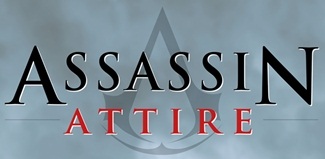
If you're going to be an assassin, you've got to look the part, and nobody has defined deadly good looks better than the Assassin's Creed series from Ubisoft. This infographic examines each costume through the series' progression from Altair all the way to Edward, the latest lead in Assassin's Creed IV: Black Flag, where we (finally) get to run around as a limber, parkour pirate aficionado! We hope this guide is a fun look back at once was, as well as a useful tool in crafting your own Assassin's Creed costumes. So, jump into the Animus and check it out!
[click on the infographic for a larger view]
Embed this Image on Your Site:
Assassin Attire: The Ever-Changing Style of Assassin's Creed Transcript
Altaïr Ibn-La'Ahad
Assassin's Creed
Robes: Altaïr—whose name actually means The Flying One—achieved a bird silhouette by bringing the hood of the robes to a point and the split in the back of the robes formed two wings when descending upon a hapless target. In addition, the white color allowed Altaïr to disappear into crowds of holy men nearly flawlessly.
Hidden Blade: Initial use of the trademark assassin hidden blade came at the cost of the wielder's ring finger. The act of sacrificing a finger became an important part of the assassin initiation ritual.
Ezio Auditore da Firenze
Assassin's Creed II
Robes: Ezio's robes continued the bird of prey motif with additions evocative of Renaissance-era Florentine fashion, including elaborate embellishments around the assassin logo and the addition of an intricately crafted doublet.
Hidden Blades: Ezio kept all his fingers. After being gifted insight from the Apple of Eden, Altaïr learned of a way to modify the hidden blade so the wearer would no longer have to sacrifice his or her finger to use it.
Ezio Auditore da Firenze
Assassin's Creed: Brotherhood
Robes: Upon becoming a master assassin, Ezio's garb took on the more traditional appearance, verging closer to the robes worn by his ancestor, Altaïr.
Cape: The cape was a traditional item of outerwear prior to the production of mass-produced coats. Originally used to protect the rest of the clothing underneath the cape, it later became an accessory to show status, including—as was used in the game—to indicate familial ties or city of origin.
Ezio Auditore da Firenze
Assassin's Creed: Revelations
Robes: For his journey to the mountain city of Maysaf, Ezio had a new set of robes created which strayed from tradition by being darker in color.
Cape: During an ambush in Maysaf, Ezio removed his cape before engaging his attackers, and never replaced it.
Connor Kenway
Assassin's Creed III
Robes: The robes Connor used were again designed with blending in mind. His robes were evocative of the uniform of the continental army, allowing him to infiltrate and blend in during crucial moments surrounding the founding of the United States.
Tomahawk: A traditional weapon among the Native Americans of the Northeast, Connor's tomahawk was obviously made using methods not available to the Mohawk, but was passed down through several generations of assassins.
Aveline de Grandpré
Assassin's Creed III: Liberation
Robes: Choosing to forgo the usual assassin hood, Aveline instead wore a tricorne—a three-corner hat that was popular in the 18th century—with the front point acting as the iconic assassin "beak".
Pistol: Flintlock pistols were perfect for short-range battles on deck. They were not very effective from afar and they could only get one shot, but in close quarters, the only thing that would beat it would be a blunderbuss.
Edward Kenway
Assassin's Creed IV: Black Flag
Robes: Eschewing the traditional Assassin's Creed design shorthand of the robes and attire being evocative of a certain time period and place, Edward's attire all points to one thing, his profession: a pirate.
Cutlass: The cutlass was a favored weapon among naval warriors because its short reach could be used in tight quarters below deck, but its heft was such that it could easily cut through thick ropes used on ships.
Sources: Gamespot, Games Radar, IGN, Wikia, Wikipedia

